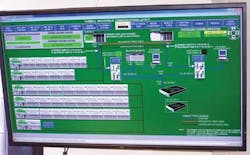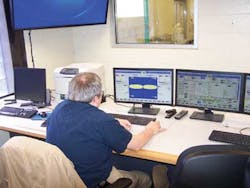To protect area streams and rivers, the City of Detroit began building a network of combined sewer overflow basins 25 years ago. Today, the department operates eight such basins, strategically sited in places where storm runoff would otherwise reach area rivers. By capturing and substantially treating the stormwater, the basins play a major role in protecting the surrounding watersheds, and the people and wildlife living there.
In just the first three months of 2011, for example, the basins collected more than 5 billion gallons of runoff that would have otherwise escaped into waterways. While a third was pumped to the main plant for treatment, the rest of that water was treated in the basins.
Each combined sewer overflow facility differs somewhat in size and design, but all basically apply the same treatment process: retaining the overflow, mechanically screening out solids, and disinfecting the water with sodium hypochlorite (bleach). Basins also have equipment that operators use to monitor flow rate and volume, collect samples, remove residual water from the basins, and clean them after a wet-weather event.
Despite their similar functions, the basins' process control instruments vary widely. That's partly because the basins were constructed over the course of the last three decades at a time when automated control technology was quickly evolving. The comparatively slow pace of public works projects was also an issue. From concept to commissioning, each basin required several years to complete because of strict municipal codes requiring public planning, open bidding and official oversight. Meanwhile, federal and state water quality standards were becoming more stringent, adding another layer of complexity.
"Through the years, we've had to update the process control systems at various basins to comply with changing regulations," said Anil Gosine, Process Control System Administrator for the Detroit Water and Sewerage Department (DWSD). The result is a "myriad of different process control systems at different locations. At one basin, we have process control equipment from four different vendors."
Such a hodge-podge of legacy equipment makes integration difficult or impossible.
"The lack of a standardized platform also hampers troubleshooting and maintenance," Gosine said. "Inventory is another problem, because we need to keep so many different spare parts on hand."
In 2004, DWSD hired a consultant to design new, more effective and efficient control systems for two existing Combined Sewer Overflow Facilities. DWSD engineers specified Rockwell Automation as the vendor for the process control systems after performing a life cycle cost analysis.
The new system leverages the company's PlantPAx™ Process Automation System, which is an integrated control and information system. System integrator Process Control & Instrumentation (PCI), LLC, was awarded the contract for replacement of non-functional control system instrumentation at two DWSD CSO Basins. PCI, a control engineering firm with an office in Detroit, worked with DWSD on other recent projects, giving PCI engineers a good understanding of the DWSD overall SCADA system.
But PCI faced a dilemma when it received the contract to retool the basins. The company had strategically offered the lowest bid to win the project with DWSD, as well as partner with Rockwell Automation for the first time. However, PCI engineers were concerned that the total cost of replacing the obsolete control systems would exceed the agreed-upon contract amount.
Rockwell engineers recommended a solution that kept the project within budget – its PlantPAx Process Library and Water/Wastewater Accelerator toolkit. The process library is a software application for the Logix Control Platform that includes an array of pre-engineered code that can be used in various applications. It also incorporates custom faceplates based on specific plant roles, information-laden icons and full documentation.
The Water/Wastewater Accelerator toolkit customizes those elements to significantly reduce the time required to design, install, operate and maintain a wastewater project. The toolkit contains configured files, selection tools and examples of how to connect the Allen-Bradley® ControlLogix® controller to the facility's human machine interface (HMI) hardware and other devices over EtherNet/IP™ and DeviceNet™ networks. The toolkit also provides system architecture drawings, basic status, control and diagnostic logic, as well as faceplates for FactoryTalk® View Site Edition HMI software from Rockwell Automation used in the new Detroit basins.
"In the past, we'd have to program the HMI separately from the controller and then link them together. The toolkit comes with 80 percent of the necessary code, predefined and factory-tested. So you're free to focus on customizing the machine control for the customer," said PCI's controls engineer on the DWSD basins project.
The Rockwell team helped train PCI's engineers on how to use the process library and the accelerator toolkit to custom configure the system for the Detroit basins.
"We needed to modify the toolkit to make the process data presentation familiar to DWSD operating folks," the PCI engineer said. "Some graphic faceplate elements didn't align with DWSD's color and naming conventions. For instance, they were used to seeing a red light when a piece of equipment was turned on, instead of the green light built into the process library. So we made that change and others that created a special standard toolkit just for Detroit."
Results
The PCI engineer estimated that the process library and toolkit cut his work in half for both basins, saving around $120,000 in programming and systems-integration time. Another $90,000 was saved in factory-acceptance testing and startup/commissioning.
"Programming the first motor took two hours, but after that I just had to copy and paste the code," said the engineer, who now is working on his fourth project using the process library and toolkit. "The cooperation I've gotten from Rockwell Automation has been amazing. I had the opportunity to interface with the original programmer of the toolkit to make the changes as needed."
The lead engineer on the toolkit was also among the Rockwell experts who traveled to Detroit to demonstrate the advantages of the system, and later returned to conduct project workshops for city engineers and wastewater operators.
DWSD officials estimate the new tools from Rockwell provided a 50 percent reduction in design time, contract oversight, and post-contract documentation and support.
"There's a much shorter learning curve for the operators with the PlantPAx system," said Gosine, who helped oversee the project for DWSD. "We also have access to a lot more data in an integrated format at these two basins. That has really improved the diagnostics, allowing more preventive and predictable maintenance."





